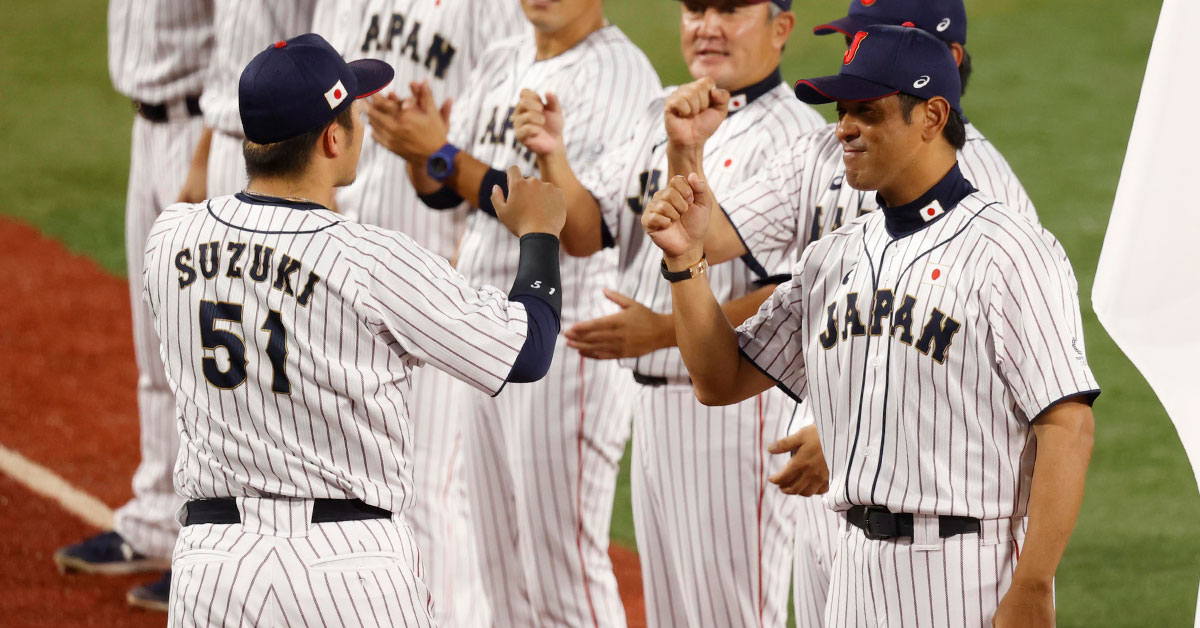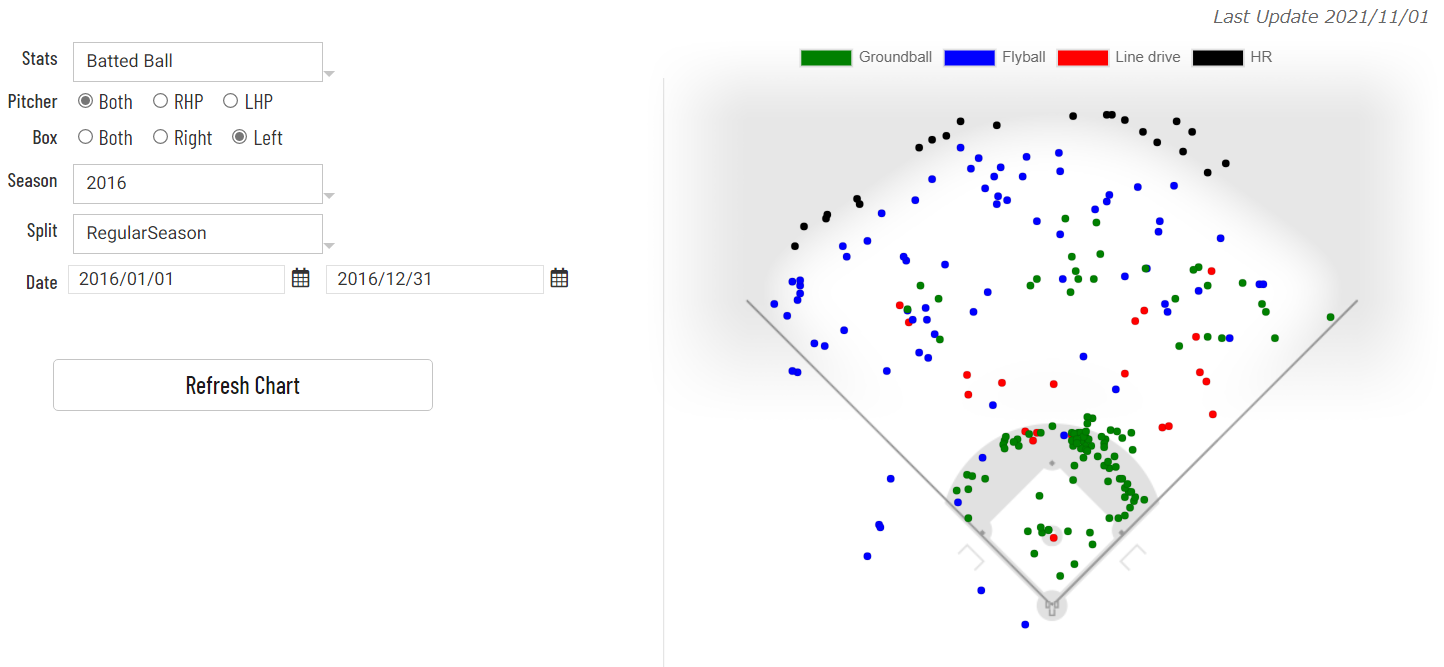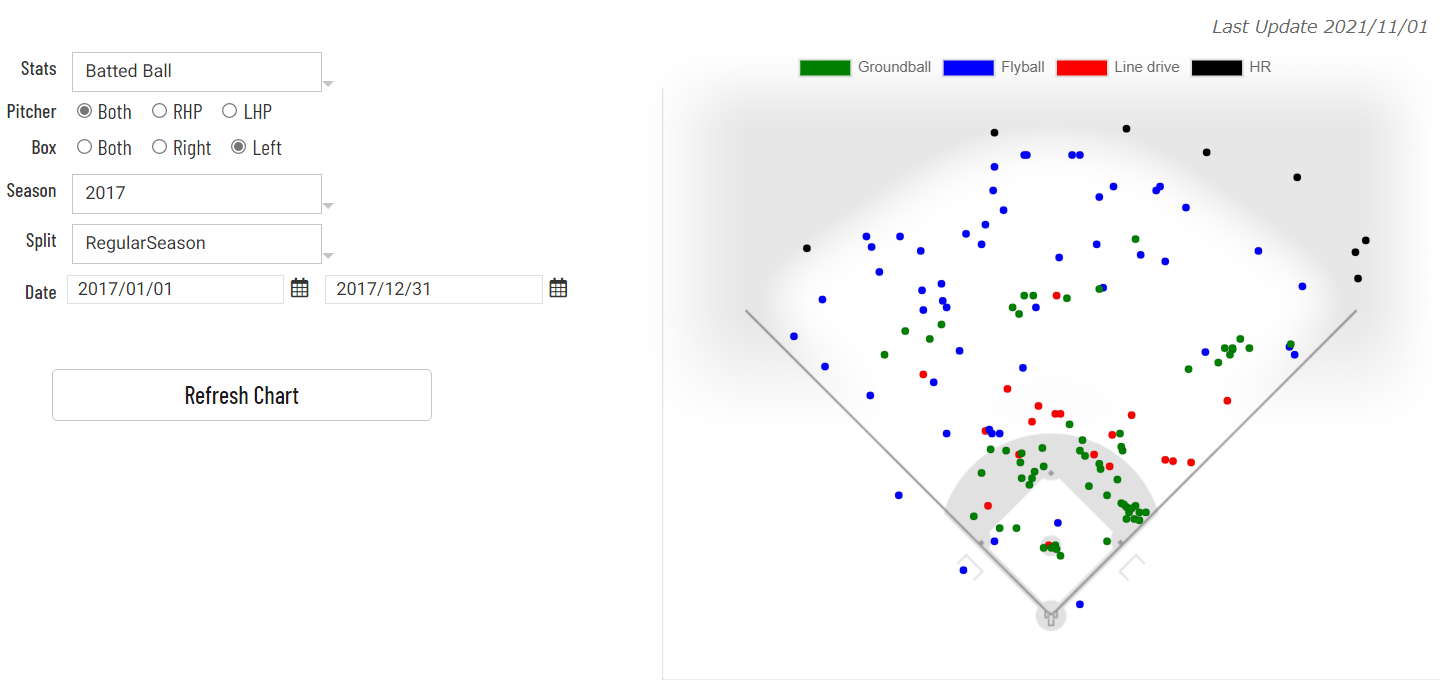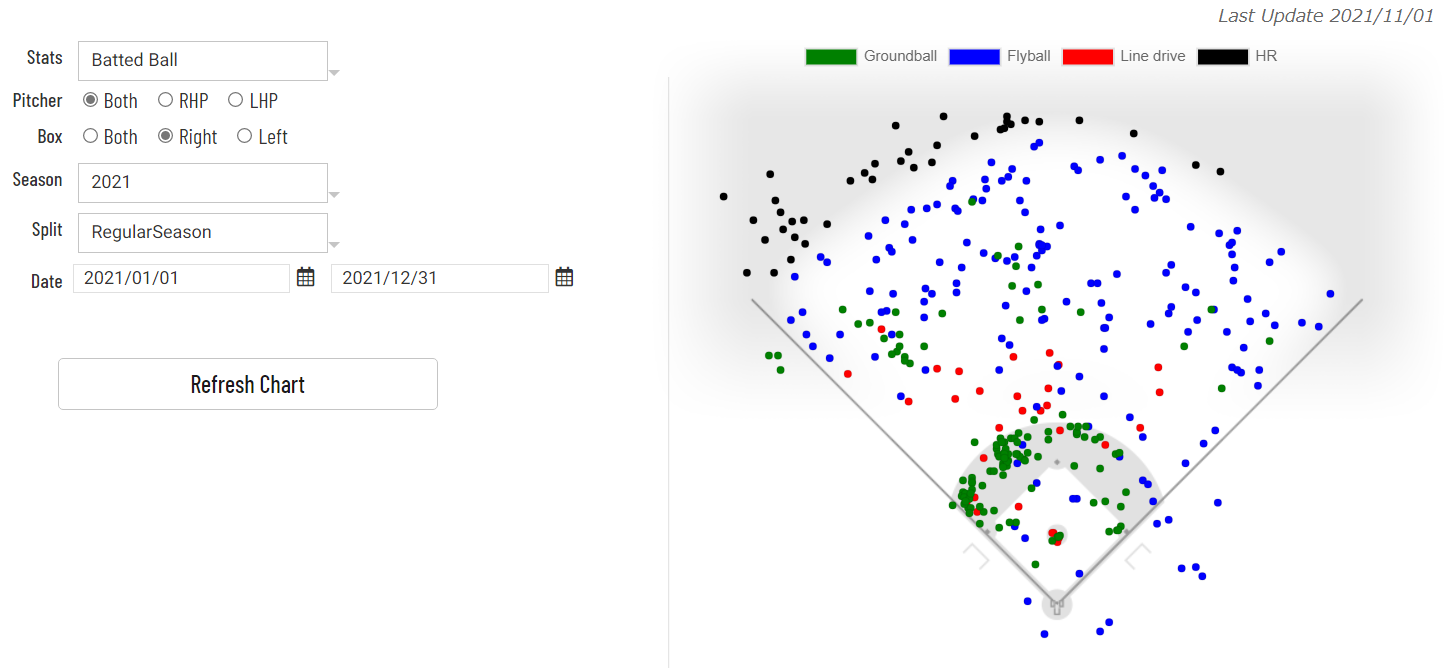How Does Seiya Suzuki Stack Up?

With Japanese outfielder Seiya Suzuki signing with the Chicago Cubs (written about by Kevin Goldstein here while Dan Szymborski ran projections on him here), I wanted to compare him to other Japanese position players who have moved to MLB in recent years. The comparisons I made were to the final NPB years of Shohei Ohtani, Yoshitomo Tsutsugo, and Shogo Akiyama. But considering Ohtani was injured in 2017, his stats will be from both the 2016 and 2017 seasons. Data is based on 1.02 – Essence of Baseball public data managed by DELTAGRAPHS.
| Player | Year | PA | Batting | Base Running | Fielding | Pos | WAR |
|---|---|---|---|---|---|---|---|
| Shohei Ohtani | ’16 | 382 | 33.2 | 3.4 | -0.2 | -5.9 | 4.4 |
| Shohei Ohtani | ’17 | 231 | 15.9 | 0.3 | 0.2 | -5.2 | 1.9 |
| Tsutsugo Yoshitomo | ’19 | 557 | 23.3 | -1.5 | -16.7 | -9.8 | 1.3 |
| Shogo Akiyama | ’19 | 678 | 31.0 | 2.3 | -4.3 | 4.7 | 5.6 |
| Seiya Suzuki | ’21 | 533 | 57.6 | -0.4 | 11.2 | -4.4 | 8.6 |
Suzuki posted 8.6 WAR in 2021, the best for position player last year. His high WAR is based on great batting value (+57.6 per 500 PA), higher than Ohtani (+43) and twice that of Tsutsugo (+21) and Akiyama (+23). His baserunning value of -0.4 is average in NPB, and his total baserunning value of +1.4 from 2019-2021 is neither good nor bad. Meanwhile, he is a good right fielder, putting up a fielding value of +11.2 (equal UZR). Tsutsugo (-16.7) is a left fielder and Akiyama(-4.3) is a center fielder, so we cannot simply compare them, but I think we can expect better fielding stats than Tsutsugo in MLB.
| Player | Year | PA | AVG | OBP | SLG | wRC+ |
|---|---|---|---|---|---|---|
| Shohei Ohtani | ’16 | 382 | .322 | .416 | .588 | 181 |
| Shohei Ohtani | ’17 | 231 | .332 | .403 | .540 | 164 |
| Tsutsugo Yoshitomo | ’19 | 557 | .272 | .388 | .511 | 136 |
| Shogo Akiyama | ’19 | 678 | .303 | .392 | .471 | 140 |
| Seiya Suzuki | ’21 | 533 | .317 | .433 | .639 | 199 |
Suzuki’s OBP, SLG, and wRC+ are better than those of the comparison players in their final NPB years. In particular, he was the only one to slug over .600. This is a level completely above sluggers like Ohtani and Tsutsugo. Suzuki has the best slash line of any fielder who has recently moved to MLB.
| Player | Year | PA | K% | BB% | ISO |
|---|---|---|---|---|---|
| Shohei Ohtani | ’16 | 382 | 25.7 | 14.1 | .266 |
| Shohei Ohtani | ’17 | 231 | 27.3 | 10.4 | .208 |
| Tsutsugo Yoshitomo | ’19 | 557 | 25.3 | 15.8 | .239 |
| Shogo Akiyama | ’19 | 678 | 15.9 | 11.5 | .168 |
| Seiya Suzuki | ’21 | 533 | 16.5 | 16.3 | .322 |
Suzuki’s excellent slash line is based on his stable stats, like K%, BB%, and ISO, which are outstanding compared to other recent Japanese hitters.
Suzuki’s K% (16.5) is lower than other sluggers and near that of contact hitter Akiyama (15.9). Meanwhile, Suzuki’s BB% (16.5) is highest among the recent Japanese hitters. Suzuki’s ISO (.322) is outstanding compared MLB’s slugger Ohtani (2016 NPB: .266, 2017 NPB: .208), who hit 46 homers with a .335 ISO for the Angels in 2021.
| Player | Year | O-Swing% | Z-Swing% | O-Contact% | Z-contact% |
|---|---|---|---|---|---|
| Shohei Ohtani | ’16 | 31.1 | 66.4 | 61.5 | 82.2 |
| Shohei Ohtani | ’17 | 31.0 | 63.5 | 56.4 | 74.1 |
| Tsutsugo Yoshitomo | ’19 | 21.9 | 66.8 | 60.4 | 83.0 |
| Shogo Akiyama | ’19 | 24.8 | 66.8 | 68.8 | 87.0 |
| Seiya Suzuki | ’21 | 19.8 | 57.7 | 57.9 | 89.3 |
Suzuki has earned many walks thanks to excellent pitch selection. His O-Swing% and Z-Swing% are the lowest of the group. He swings carefully and deliberately, and his Z-Contact% is the highest. When Suzuki swings, he makes contact 89.3% of the time in the zone. I also think Suzuki’s O-Swing% can be expected to be better than other Japanese hitters that have come to the majors, and maybe even average MLB hitters.
| Player | Year | FB% | HR/FB | Pull% | Cent% | Oppo% |
|---|---|---|---|---|---|---|
| Shohei Ohtani | ’16 | 42.4 | 22.7 | 32.6 | 45.7 | 21.7 |
| Shohei Ohtani | ’17 | 42.3 | 13.3 | 35.3 | 41.0 | 23.7 |
| Tsutsugo Yoshitomo | ’19 | 52.8 | 16.9 | 33.0 | 38.1 | 28.8 |
| Shogo Akiyama | ’19 | 40.2 | 9.9 | 37.6 | 38.6 | 23.8 |
| Seiya Suzuki | ’21 | 57.1 | 18.9 | 40.4 | 40.6 | 19.0 |
Suzuki is a powerful flyball and pull hitter. His FB% (57.1) is higher than Tsutsugo (52.8). Suzuki’s HR/FB (18.9) is lower than Ohtani’s HR/FB (22.7) in 2016, but higher than 2017 (13.3). Given that Ohtani was injured in 2017, Suzuki’s power is slightly less than a healthy Ohtani but could be expected to be as good or better than Tsutsugo’s (16.9). Suzuki’s direction of hitting is distinctive, and he clearly hits more pitches in the pull direction than the most recent Japanese hitter. His batted balls are often hit in the pull direction, and he is clearly pulling the ball more than the other recent Japanese hitters to go over.
Let’s look at some spray charts. Here is Ohtani in 2016:
And here is Ohtani in 2017:
Now here is Suzuki in 2021:
Let’s compare the spray charts of Suzuki and Ohtani using this data from 1.02. Ohtani’s flyballs are distributed in the opposite direction from center, and his homers occur in a wide angle. On the other hand, Suzuki’s flyballs are distributed in the pull direction from center, and his homers are biased in the pull direction. While Ohtani uses his innate power to hit wide-angle stand-ins, Suzuki’s home runs are produced by his hard pulling flies. Ohtani hit 46 homers last year, partly due to an increase in pulled flyballs from 2018 to 2021. The key to Suzuki’s success as a slugger in MLB will be whether he can adjust like Ohtani to fastballs that average 5 km/h (3 mph) faster than NPB fastballs.
| Player | League | Year | POS | Inn | ARM | RngR | ErrR | UZR |
|---|---|---|---|---|---|---|---|---|
| Seiya Suzuki | NPB | 19-21 | RF | 3284.1 | 7.3 | 12.8 | 0.5 | 20.6 |
| Leonys Martin | NPB | 19-21 | RF | 2005.1 | 9.9 | -3.6 | -0.7 | 5.4 |
| Leonys Martin | MLB | 17-19 | CF | 1399.0 | 1.7 | 4.7 | 0.3 | 6.7 |
Suzuki is a strong fielder in right. His UZR is +20.6 in NPB from 2019 to 2021, and his arm (+7.3) and RngR (+12.8) numbers are both good. As a defensive comparison for Suzuki, I picked an outfielder who has played the same position as Suzuki in NPB for the past three years and has played his share in MLB. That player is Leonys Martin, a good defensive outfielder who played for the Rangers, Mariners, and others.
Martin, who played well as a center fielder in the majors, played right field in Japan at the same time as Suzuki. Suzuki’s RngR (+12.8) was above Martin’s RngR (-3.6), and while Suzuki’s arm (+7.3) was lower than Martin’s arm (+9.9) a little, a value of +7.3 is pretty good. While there is no simple comparison, Suzuki posted a better UZR than Martin in the same league, who was an above-average center fielder in MLB. This should be a guideline to guarantee a certain level of defensive ability.
Seiya Suzuki is the best right fielder in NPB. His swing is as powerful as Ohtani, more careful than Tsutsugo, and makes more contact in the zone than Akiyama. And he provides solid defense based on a strong arm and wider range than Leonys Martin. When Suzuki adjusts to MLB-level fastballs and can pull flyballs, he will make plays that will fascinate his fans.
Hiroshi Miyashita is an analyst for DELTA Inc. The NPB data included in this article is published at data site 1.02 – Essence of Baseball, operated by DELTA Inc. DELTA Inc. is Japanese Baseball Analysis Company and can be found on Twitter @Deltagraphs.



Really well done, Hiro! Dave, sign him up!
This was great info!
Great write-up!
Wow, as a Cub fan, this is very exciting to read
Well-explained! I was looking for a way to measure him up and this is the best article I’ve found. Sure, it only uses Suzuki’s best season, but still, it’s very informative.